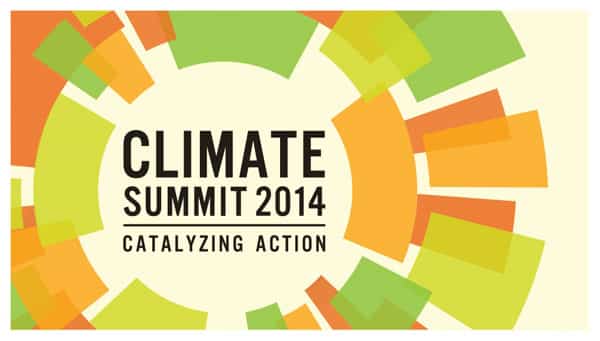
For UN Secretary General Ban Ki-moon, the climate change issue is frustrating. His only hopes now lie in Paris, which will be the stage of the 2015 United Nations Climate Conference. His ambition is to bring together the uneven patchwork of binding and non-binding agreements in one solid universal and legal framework. To prepare the ground work for Paris, world leaders gathered in September in the New York Climate Summit and will meet again in December in Lima to draft the agreement.
The international community has never delivered when it comes to a climate agreement. Examples being the latter failure of Copenhagen in 2009 or the controversial Kyoto Protocol of 1997. In the aftermath of the disappointment of a slow motion multilateral approach, there has been an increase in action at a national level towards the climate dilemma.
In New York, Obama and Gaoli gave eloquent speeches. A response to the climate issue should and must come from the world’s major carbon emitters, who are inevitably the most controversial players of the game. Encouragingly, the US and China, who are reluctant to sign a legally binding agreement, are now, more than ever, under the spotlight. The time for dithering should be over, but both countries face their own deadlocks to commit; a divided Senate that could block any treaty-making progress on the American side, and China’s attempts to use its developing nation status as an excuse for action, on the other.
This lack of real commitment is what exasperates Ban Ki-moon and promoters of a universal agreement. Because whilst gloomy environmental data (carbon emissions reached a new record in 2013, at 36 billion metric tons, 2.1 percent more than the previous year) and extreme climate disasters herald what is yet to come, politicians only take baby steps towards an agreement.
But not all is lost as inaction is not the rule: countries have begun to tackle the climate problem themselves. Some experts, such as Timothy E. Wirth and Thomas A. Daschle, defend in a Yale Environment 360 publication, that there is no real need for a global framework for climate change, as the growth of cleaner energy alternatives will give natural incentives for countries to “clean up their act”.
The climate puzzle is being solved by countries and businesses, and there is evidence this has already started to happen:
- The private sector is coming to realize the benefits of green economics. Such is the case that even the Rockefeller Brothers Fund– an all-time synonym for oil –, has recently announced, during the bustle of the Climate Summit in New York, its intention to sell fossil fuel assets and to divert them in renewable alternatives. Another example is the Brazilian wind power market, which is now competitive without relying on subsides. Advances in technology will surely help other renewable markets flourish in the same way.
- States are increasingly trying to push business towards the renewable energy market. A clear example is the European Union. The EU cannot brag about its carbon pricing – in 2008 it was 30€ per ton, which has dropped to today’s 6€ – but European leaders are in the mood to set an example. The Emissions Trading System has been one of the biggest bids, relaying on a cap-and-trade system (setting greenhouse gas emission ceilings with limited allowances for industries and installations to trade within themselves) that could help inflate the price for carbon and make diversification towards other energy markets easier, and more desirable. In China, there are pilot cap-and-trade projects being tried in a number of cities and provinces to evaluate their impact and effectiveness. Critics of this system in the EU call for stricter energy efficiency targets or even a carbon tax. In fact, this latter tool, while unpopular in the US, is under consideration in China, despite its negative impact on business. Another example of EU actions is the 20/20/20 targets (20 percent reduction in greenhouse gas emissions, 20 percent target for the weight of renewables in the energy mix and 20 percent increase in energy efficiency by 2020) which have been reviewed in October by the European Commission. Now, the objectives for 2030 (despite controversy with countries such as Poland that blindly defends its coal industry) are 40/27/27. All these policies can be questioned, but there is no denying that they are a step towards action.
Just after the renewing of the EU targets, earlier this month, it was the US and China’s turn to surprise the world with a set of bilateral climate objectives. Both countries, like the EU, have designed targets for the reduction of carbon emissions: China will try to make carbon emissions peak before 2030 and the US will aim to reduce 26-28 percent its carbon levels of 2005 by 2050 (advancing at a slower pace than the European aim of 40 percent reduction by 2030 of 1900 levels). Also, China has pledged, again like the EU, to increase the weight of renewables in the energy mix by 20 percent by 2030 (which was Europe’s initial reduction promise for 2020) which is now even more ambitious.
Yet, this is a significant first step. It is the symbolism behind this announcement that makes it historic, as the Obama Administration has said. Those two countries, which combined are responsible for 45 percent of the world’s greenhouse gas emissions, have finally left behind the ubiquitous and stubborn excuse of paralysis because of the other’s own paralysis.
This exact message, in this precise moment, was what the world needed to energize the talks coming up next year in Paris, and build momentum toward the imminent Lima Conference. Although they are bilateral targets, born outside the UN framework, we cannot allow ourselves to be shortsighted and ignore its significance for a global agreement.
Nonetheless, a binding agreement will surely be much more difficult to obtain than a set of climate targets; we will soon see in Lima if this bilateral carbon deal can easily translate into a multilateral commitment. Especially taking into account that the content behind these bilateral targets is more controversial than the significance of the overall message, as both the US and China will probably struggle to achieve their objectives.
This bilateral announcement is the first brick in the wall for credible negotiations towards Paris. But, in the waiting for global action, the world has not remained motionless, nor has it held its breath until the international community reaches an agreement. On the contrary, worldwide nations have come to terms with the existence of an ever growing problem to be highlighted in the political agenda. It may not be ideal, but solutions are arising for a problem that can not wait for the formalities of negotiations.
So as world temperatures continue to steadily rise and scientists continue to constantly warn of the threat of surpassing the 2°C threshold, individual responses have flourished. A binding legal framework and climate action have proven not to be mutually exclusive. Too little too late has come from those who carry the biggest responsibility of the deterioration of our environment. The rest of the world has wondered: why wait for a global agreement to go green once and for all?

